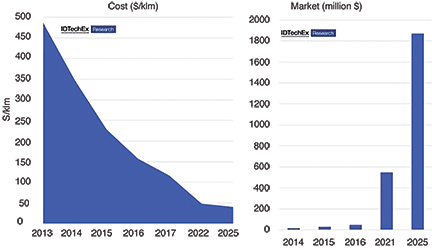Will OLED lighting eventually disrupt or fade away?
18 May 2016
Editor's Choice
Opto-Electronics
By Dr Khasha Ghaffarzadeh, IDTechEx.
OLED (organic light emitting diode) lighting technology has faced a difficult challenge since its very beginning, in the shape of inorganic LEDs. The challenge was that LED lighting got there first and leveraged its accumulated production experience to improve its performance and to reduce its costs. This in turn created a large gap between the two technologies that shows no signs of narrowing.
The OLED lighting industry generally had a confused commercialisation strategy, while LED incumbents viewed OLED technology as a threat and, as such, invested only to hedge their bets. Some ignored the potential uniqueness of OLED lighting, trapping themselves in the rigid (glass-based) and/or high-power corner of the markets.
Unsurprisingly, all these led to failures and disillusionment. Many simply gave up and now few committed players remain. Most notable amongst them are LG Chem and Konica Minolta. Both are from Asia and both see in OLED lighting a way into the immense prize that is the lighting market.
IDTechEx Research had anticipated these trends and developments in its market research report ‘OLED Lighting Opportunities 2015-2025: Forecasts, Technologies, Players’. It warned about the consolidation, confused commercialisation strategies and also the limited short-term market prospects of OLED lighting technology. Indeed, in 2014, IDTechEx forecast that the market would be smaller than $80 million by 2018 and still believes that this will hold true.
Left: IDTechEx cost projections developed in 2013. Right: Segmented IDTechEx forecast developed in 2013.
The research firm also correctly modelled and anticipated the price evolution of OLED panels, when it anticipated in 2013 that the production cost will reduce to around $200/klm by 2015. This was confirmed when LG Chem announced a very aggressive sales price of $200/klm in mid-2015. IDTechEx’s model enabled it to conclude that the panels were being sold at or below cost in order to stimulate the market.
What does the future hold for OLED lighting?
IDTechEx Research had also forecasted that the OLED lighting market will reach more than $1,8 billion in 2025 at the panel level. It still remains optimistic about the long-term prospects of this technology, because OLED lighting exhibits key characteristics of a disruptive technology: it underperforms and is overpriced when measured on the standard industry figures-of-merit such as lm/W and $/klm; but it can create new markets that value novel figures-of-merit such as large area emission, light weight and flexibility.
IDTechEx Research believes that OLED lighting can exploit these differentiators to cultivate a series of niche markets and use its accumulated industry experience to become good enough in an increasing series of established segments. This process will be helped by two fundamental characteristics of the lighting market: enormous product diversity and importance of aesthetics. This is in contrast to, for example, the photovoltaic market where there is little product diversity, therefore emerging technologies as OPVs find it exceedingly hard to create niches.
Ultimately, however, the future will depend on whether the believers will keep faith through this period of disillusionment.
For more information visit www.idtechex.com
Further reading:
20 years of precision, progress and purpose – the Jemstech journey
Jemstech
Editor's Choice Manufacturing / Production Technology, Hardware & Services
Twenty years ago, Jemstech began as a small, determined venture built on technical excellence and trust. Today, it stands among South Africa’s leading electronic manufacturing service providers.
Read more...
A new era in wire bond inspection
Techmet
Editor's Choice Manufacturing / Production Technology, Hardware & Services
Viscom is developing a 3D wire bond inspection system that incorporates substantially improved sensors, a high image resolution, and fast image data processing.
Read more...
Energy harvesting using a battery-less IoT system
NuVision Electronics
Editor's Choice Power Electronics / Power Management
Energy Harvesting plays an essential role in the foundation of ambient IoT, a new generation of ultra-low power connected devices that operate by drawing energy from their environment instead of relying on traditional batteries.
Read more...
Questing for the quantum AI advantage
Editor's Choice AI & ML
Two quantum experts disclose high hopes and realities for this emerging space.
Read more...
From the editor's desk: Progress meets reality
Technews Publishing
Editor's Choice
In the first half of 2025, renewable energy, incorporating solar, wind, and to a lesser degree hydropower and bioenergy, has generated more electricity globally than coal did.
Read more...
From ER to effortless: The 15-year journey of Seven Labs Technology
Seven Labs Technology
Editor's Choice Manufacturing / Production Technology, Hardware & Services
What started as a business likened to an ‘ER’ for electronic components has today grown into a trusted partner delivering kitting services and full turnkey solutions – taking the effort out of electronics and helping customers truly ‘Move to Effortless.’
Read more...
The trends driving uptake of IoT Platform as a Service
Trinity IoT
Editor's Choice Telecoms, Datacoms, Wireless, IoT
IoT platforms, delivered as a service, are the key that will enable enterprises to leverage a number of growing trends within the IT space, and access a range of benefits that will help them grow their businesses.
Read more...
Interlynx-SA: Engineering SA’s digital backbone
Interlynx-SA
Editor's Choice
At the heart of the industrial shift towards digitalisation lies the growing demand for telemetry, Industrial IoT (IIoT), advanced networking, and robust data solutions, and Interlynx-SA is meeting this demand.
Read more...
Converting high voltages without a transformer
Altron Arrow
Editor's Choice Power Electronics / Power Management
With appropriate power converter ICs, such as the LTC7897 from Analog Devices, many applications can be suitably powered without having to use complex and cost-intensive transformers.
Read more...
Grinn Global: From design house to SoM innovator
Editor's Choice
From its beginnings as a small electronic design house, Grinn Global has moved into the spotlight as a system-on-module innovator working alongside technology giants like MediaTek.
Read more...


